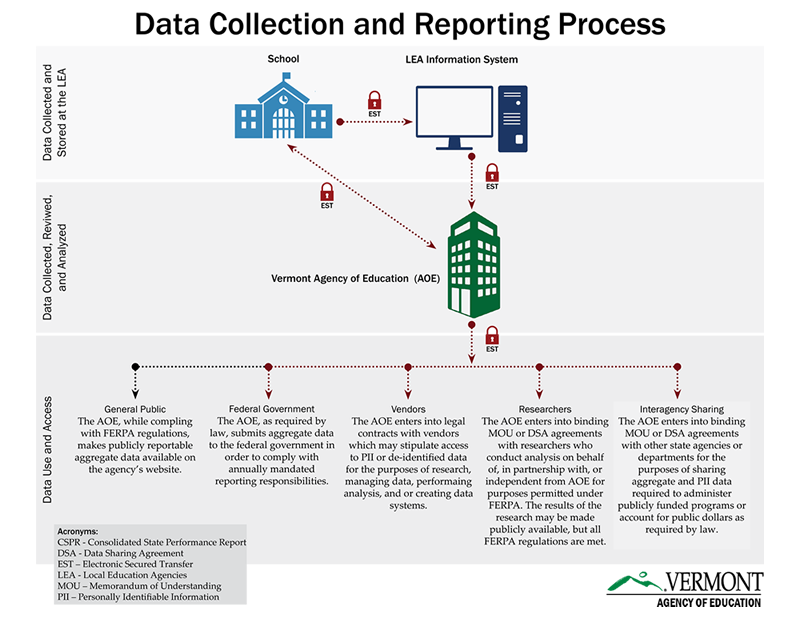Data governance describes an organization’s
- collection, management and use of data;
- identifies specific roles for carrying out this work; and
- outlines the processes by which data may be shared with external entities.
At the AOE, we know that any data-based decision-making to improve educational practice or policy must rely on reliable, robust data. This is why it is important to have transparent and explicit data governance policies in place.
AOE’s vision is to ensure stakeholders have access to timely, consistent, and accurate data to inform and support empirically-driven decisions affecting education. To facilitate the use of data for wise decision-making, stakeholders need a clear understanding of the VT AOE’s data governance program, including existing policies for: data collection and use, data privacy, suppression, data reports, and public requests for data.
 Data Collection and Use
Data Collection and Use
Both federal and state law require the AOE to routinely gather specific types of data from schools, supervisory unions, and districts. Data on student enrollment numbers and background characteristics, student performance, and financial expenditures, to name a few of the types of data collected, are used to fulfill AOE reporting obligations. Such data are also used to calculate and designate funding, ensure statutory compliance, and support state-level decision-making. In order to streamline data collection across the state, AOE has developed a series of training manuals and shared procedures for the field, as well as a robust statewide data collection system.
Data Privacy
One of the most important principles of data governance is ensuring the protection of private student information. The federal Family Education Rights and Privacy Act (FERPA) requires entities that receive federal funding (such as the AOE, institutions of higher education, etc.), to guard against disclosure of Personally Identifiable Information (PII), except under very specific and limited conditions. In order to protect individual students’ privacy, aggregated (i.e., grouped) data are typically reported in public-facing documents.
FERPA gives parents certain rights with respect to their children's education records. A school must provide a parent with an opportunity to inspect and review his or her child's education records within 45 days following its receipt of a request. Contact the school your child attends for more information on how to review his/her education records.
Suppression
Why does this report I’m looking at have so many asterisks? To protect student privacy, any sensitive and/or potentially personally identifiable information from fewer than 11 students is “suppressed” (i.e., asterisked).
Why? This is a standard procedure performed to ensure that others cannot discern who individual students are in a report, also called de-identification by the Privacy Technical Assistance Center. AOE employs primary suppression by suppressing information when cell sizes are less than 11 students. In addition, AOE sometimes has to perform complementary suppression or suppression that occurs if more than one piece of information that has been released to the public would enable others to discern the identity of individual students in a report.
For additional information on suppression, we recommend the following the federal Privacy Technical Assistance Center. Also review Vermont State Board of Education Rule 2555, to see Vermont's rule ensuring student confidentiality.
The large majority of states use 10-12 as their minimum reporting cell size. Vermont is in step with what most other states do with respect to suppression logic.
Education Data
Looking for data? Check out the list of our data and reports below.
- Accountability
- Annual Performance Report
- Annual Report and Budget Book
- Annual Statistical Report of Schools
- Average Daily Membership
- Child Data Count
- Common Data Project
- Cost, ADM, Child Count for Special Education
- District Data Profile
- Educator Disciplinary Actions
- ELA and Math Assessments
- Excess Spending Threshold
- Free and Reduced Lunch
- HHB Report
- Kindergarten Survey Report
- Legislative Reports
- NEAP
- Per Pupil Spending
- Postsecondary Prep Tests
- Postsecondary Enrollment
- School Comparison for Cost Effectiveness
- School Finance Documents
- Science Assessment
- Small School Grants
- State Report Card
- Teacher and Staff FTE Report
- Technology Survey
- Tuition Rates
Requests for Data
Periodically, members of the public may find that they have additional needs for state education data that are not met by the existing reports (see above). We have provided two mechanisms by which the public may apply for accessing such data.
- Data Request Form should be used to make simple, non-research data requests. (Examples: media story, simple fact-checking.)
- Research Request Application should be used to make research data requests. The completed application is necessary in order for AOE to review the purpose of the research, specific data involved, and level of AOE staff time and effort needed to complete the request. It is also necessary to determine whether the research request is in line with the AOE’s analytic priorities. All research requests require pending or received Institutional Review Board (IRB) approval before they can be reviewed.
Note: The agency will suppress data that is based on student counts of less than 11 students for all data requests. This is to ensure that student privacy is maintained.
To make a public record request pursuant to the Vermont Public Records Act, 1 V.S.A. § 317, visit our Public Information page.
